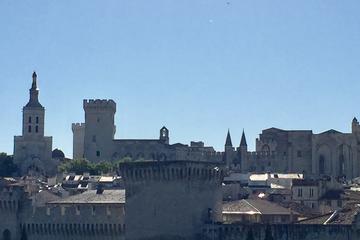
Sardinia, Italy
by Cornelius Myers
Down through history, ancient civilizations have left inscrutable and symbolic artifacts for us to ponder and puzzle over. Stonehenge, the Nazca lines, the Pyramids at Giza, the Sphinx, the Easter Island Moai and Machu Picchu all have remained largely unexplained and mysterious. Similarly, the Nuraghe of Sardinia today are still a complete enigma and the focus of fierce academic and archeological discussions as to their origins and purpose.
Some archeologists maintain that the structures were royal palaces or religious temples; others say they were simply dwellings, military strongholds, the house of the chief of the village, or a meeting place for wise men or kings. What is known is that these ancient megalithic edifices – having the shape of a truncated conical tower resembling a beehive – have come to be the symbols of Sardinia and it’s distinctive cultural history.
 Today, there are more than 8,000 nuraghes still standing from what is estimated to have numbered more than 30,000. They were most prevalent in the northwest and south-central areas of the island and are usually located in a panoramic spot – strategically located on hilltops to control important passages.
Today, there are more than 8,000 nuraghes still standing from what is estimated to have numbered more than 30,000. They were most prevalent in the northwest and south-central areas of the island and are usually located in a panoramic spot – strategically located on hilltops to control important passages.
They have no foundations and stand only by virtue of the weight of the stones – some of which weigh as much as several tons. Some of the structures stand more than 20 meters (60 feet) in height. Everything in the nuraghes is made of stone laid upon stone, with no lime or concrete used. Considering the frequency of invasions and conquests through the millennia, it is tribute to the ancient builders that so many have survived.
The most important complex of nuraghes is Su Naraxi di BaruminI, centered around a three story tower built around 1500 BC. It has been designated as a UNESCO World Heritage Site. The highest and most imposing is the Nuraghe Sant’ Antine, near Torralaba. However, even the smallest of the structures is awe inspiring and unstintingly mysterious.
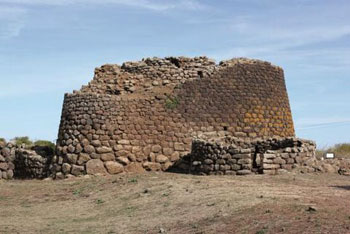 They all are incredibly accessible and available to explore. When you enter a nuraghe, stand in the middle of the cone and stare up at the opening above you, the presence of it’s former inhabitants is almost palpable. The stone stairs to the various interior levels wind-up the sides of the structure leading to antechambers and strange rooms. There is a strong sense of design and intention.
They all are incredibly accessible and available to explore. When you enter a nuraghe, stand in the middle of the cone and stare up at the opening above you, the presence of it’s former inhabitants is almost palpable. The stone stairs to the various interior levels wind-up the sides of the structure leading to antechambers and strange rooms. There is a strong sense of design and intention.
It is generally agreed that they were constructed in the middle of the Bronze Age – 18th-15th centuries BC; although some have been dated at 3500 BC. Scholars also agree that the Nuragic civilization produced the most advanced and monumental architecture for this time frame in the western Mediterranean, including the Greek colonies of Magna Graecia.
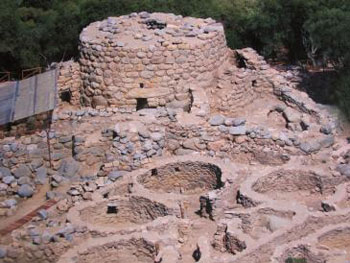 Having stated that, it remains a complete mystery as to who were the Nuragic people. Some clues can be found at The National Archeological Museum in Cagliari. It holds most of the materials discovered in the Nuraghes. They did produce art in the form of beautiful small bronze statues; typically representing Gods, the chief of the village, soldiers, animals and women. There are also stone carvings or statues representing female divinities.
Having stated that, it remains a complete mystery as to who were the Nuragic people. Some clues can be found at The National Archeological Museum in Cagliari. It holds most of the materials discovered in the Nuraghes. They did produce art in the form of beautiful small bronze statues; typically representing Gods, the chief of the village, soldiers, animals and women. There are also stone carvings or statues representing female divinities.
They venerated water and celebrated it’s sources with magically designed springs, sacred wells and sanctuaries. Forty Nuragic wells have been uncovered. The interiors have a monumental staircase leading to an atrium and the spring. The wells are all built of stone and similar to the Nuraghe’s architecture. They are underground and womb shaped to honor the Earth Mother and fertility.
 The sacred well of Santa Cristina has a hole in the vault. Every 18 and a half years, when the moon reaches is lowest point in orbit, the moonlight strikes the hole and is reflected on the surface of the water. Sunlight is also reflected during the autumn and spring equinoxes. Through these processes we know they possessed a great knowledge of celestial cycles.
The sacred well of Santa Cristina has a hole in the vault. Every 18 and a half years, when the moon reaches is lowest point in orbit, the moonlight strikes the hole and is reflected on the surface of the water. Sunlight is also reflected during the autumn and spring equinoxes. Through these processes we know they possessed a great knowledge of celestial cycles.
The Tombs of the Giants are scattered throughout the island. So far, 320 have been found. They are monumental structures of huge granite stone stellas, placed upright, side by side, forming a semi-circle. They are all oriented toward the constellation of Taurus. The tombs are from the megalithic period and housed collective graves without distinction to status or family. It is believed that they were gateways to the afterlife.
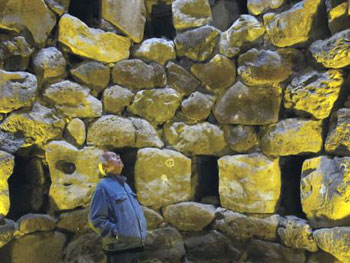 But that is where the certainties end. Scholars are not even sure of the correct name for the civilization, or even the real meaning of nuraghe. The name itself derives from the meaning of mound and cavity, and the nuraghes are built by laying big stones of similar size on top of each other, leaving a cavity in the middle which is then covered by a stone domed roof. For lack of a more informed identification, scientists accordingly have called them the Nuragic peoples.
But that is where the certainties end. Scholars are not even sure of the correct name for the civilization, or even the real meaning of nuraghe. The name itself derives from the meaning of mound and cavity, and the nuraghes are built by laying big stones of similar size on top of each other, leaving a cavity in the middle which is then covered by a stone domed roof. For lack of a more informed identification, scientists accordingly have called them the Nuragic peoples.
Sardinia is the oldest region of Italy. This archaic world has it’s roots shrouded in the mists of time. From the Neolithic period it has been inhabited by populations that have left fascinating, monumental traces of their presence, but none more mysterious and intriguing than the builders of the Nuraghe.

Cagliari: Amazing Bosa and Prehistoric Sardinia
If You Go:
About the author:
Cornelius Myers is an award-winning journalist, broadcaster, feature writer with publications in many travel magazines and newspapers including the New York Times. He’s based in Monaco and Miami.
All photographs are by Charlotte Otto Bruc.

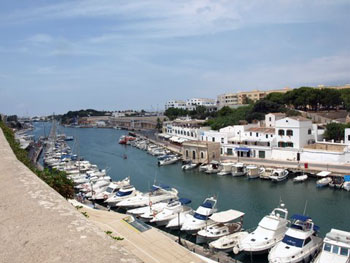
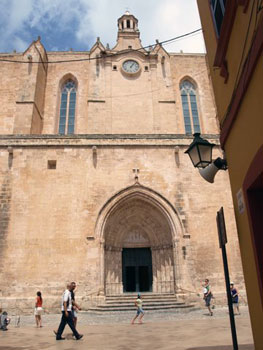 The 14th century Cathay Gothic cathedral in the Plaza de Pio XII, and its surrounding area, miraculously escaped destruction in 1558 when Barbarossa, the pirate Red Beard, attacked and destroyed the town with his Turkish mercenaries. The cathedral’s ornate Baroque style Chapel of the Souls was added in the 17th century, when much of the town was finally rebuilt. Then in the 19th century, it was finished with a neo-classical front facade. It still also contains a small minaret from the mosque that occupied its space before it was turned into a cathedral on the orders of King Alfonso III of Aragón, who took the island from its ruling Moors in 1287.
The 14th century Cathay Gothic cathedral in the Plaza de Pio XII, and its surrounding area, miraculously escaped destruction in 1558 when Barbarossa, the pirate Red Beard, attacked and destroyed the town with his Turkish mercenaries. The cathedral’s ornate Baroque style Chapel of the Souls was added in the 17th century, when much of the town was finally rebuilt. Then in the 19th century, it was finished with a neo-classical front facade. It still also contains a small minaret from the mosque that occupied its space before it was turned into a cathedral on the orders of King Alfonso III of Aragón, who took the island from its ruling Moors in 1287.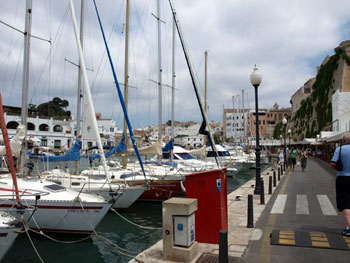 The square is edged with grand palaces on the cathedral side opposite the imposing Town Hall and theatre. Next to the theatre is a magnificent viewpoint looking out over the harbour. A couple of pavement cafes sit beyond this next to the corner that leads to the steps down to the harbour, which is lined on this side with popular restaurants.
The square is edged with grand palaces on the cathedral side opposite the imposing Town Hall and theatre. Next to the theatre is a magnificent viewpoint looking out over the harbour. A couple of pavement cafes sit beyond this next to the corner that leads to the steps down to the harbour, which is lined on this side with popular restaurants.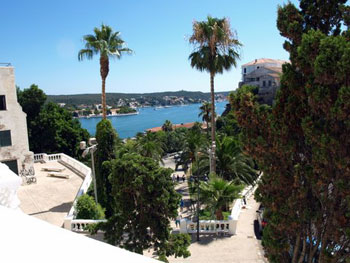 The natural advantages of the waters of Mahon meant that the British based themselves there and declared it the new capital of the island. But the clerics of the time refused to move, so Ciutadella retains its cathedral and its religious superiority.
The natural advantages of the waters of Mahon meant that the British based themselves there and declared it the new capital of the island. But the clerics of the time refused to move, so Ciutadella retains its cathedral and its religious superiority. Unlike Ciutadella, Mahon town occupies only the southern side of the port. The opposite side houses the naval base. It is also where new resorts are being developed alongside some wonderful villas that include one where Admiral Nelson and Emma Hamilton are said to have had some romantic trysts.
Unlike Ciutadella, Mahon town occupies only the southern side of the port. The opposite side houses the naval base. It is also where new resorts are being developed alongside some wonderful villas that include one where Admiral Nelson and Emma Hamilton are said to have had some romantic trysts.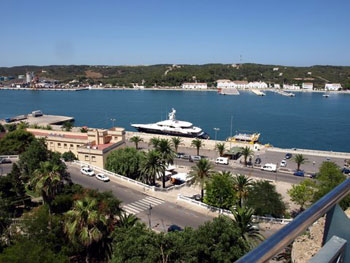 Back on the harbour side of Mahon, if it’s time for a tipple, you can head for the centuries old Xoriguer Gin Distillery, famous for supplying unique Menorcan gin to Admiral Nelson’s British sailors. Or there are plenty of good bars and restaurants on the landward side of the harbour road, or up in the town above.
Back on the harbour side of Mahon, if it’s time for a tipple, you can head for the centuries old Xoriguer Gin Distillery, famous for supplying unique Menorcan gin to Admiral Nelson’s British sailors. Or there are plenty of good bars and restaurants on the landward side of the harbour road, or up in the town above.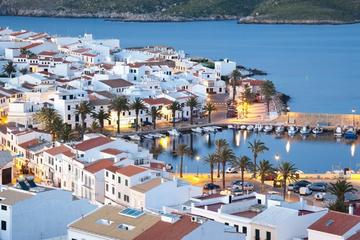

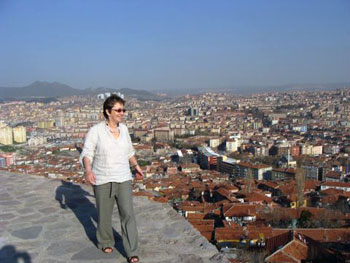 At the weekend, I decided I would see two of the three highlights recommended in my Lonely Planet Guide, saving the third till the following weekend. I wandered up to the Citadel, the oldest part of the city, the walls of which date back to the 7th century. The narrow winding streets were packed with carpet stalls and little restaurants. Women chatted by the side of the road, crocheting handbags. A family, gathered on a few steps outside a crumbling house, invited me to join them for chai. Seeing their shoes all lined up neatly to one side, I took off mine, and we smiled and giggled at each other and sipped tea for a while.
At the weekend, I decided I would see two of the three highlights recommended in my Lonely Planet Guide, saving the third till the following weekend. I wandered up to the Citadel, the oldest part of the city, the walls of which date back to the 7th century. The narrow winding streets were packed with carpet stalls and little restaurants. Women chatted by the side of the road, crocheting handbags. A family, gathered on a few steps outside a crumbling house, invited me to join them for chai. Seeing their shoes all lined up neatly to one side, I took off mine, and we smiled and giggled at each other and sipped tea for a while.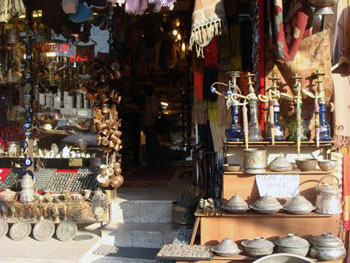 The second weekend, I visited the Citadel and the Museum of Anatolian Civilisations again: this time the only guide I could find that I would be able to understand spoke a mixture of Italian and Spanish.
The second weekend, I visited the Citadel and the Museum of Anatolian Civilisations again: this time the only guide I could find that I would be able to understand spoke a mixture of Italian and Spanish.
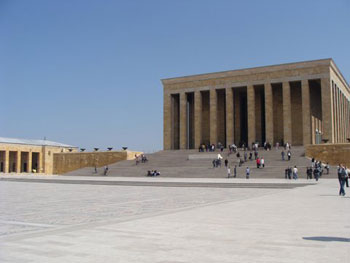 It just had to be a genuine ancient hammam. The Lonely Planet recommended Sengül Merkez Hamami. At the entrance to a quiet alleyway, below the hammam sign, two women sat on the ground sipping tea. A child played nearby.
It just had to be a genuine ancient hammam. The Lonely Planet recommended Sengül Merkez Hamami. At the entrance to a quiet alleyway, below the hammam sign, two women sat on the ground sipping tea. A child played nearby. After that, I was ready to be pampered. I understood that the even larger lady whose job it was to scrub me was the sister of the epilasion one. I lay on the marble slab. And very quietly, she began to sing, the volume gradually increasing, until her haunting, deep, sad song filled the steamy air and brought tears to my eyes – no, not tears – floods. I look up at her closed eyes, her furrowed brow, her look of concentration as she drew the cheap, hand-crocheted, garish flannel up and down my arms, her blubbery stomach filling the space between us. ‘Benli benli, benli benli,’ she sang, as I imagined a story of lost love, war, pain, death, disaster… Then a young woman beside me – yes, someone spoke a few words of English here – said ‘Hello!’
After that, I was ready to be pampered. I understood that the even larger lady whose job it was to scrub me was the sister of the epilasion one. I lay on the marble slab. And very quietly, she began to sing, the volume gradually increasing, until her haunting, deep, sad song filled the steamy air and brought tears to my eyes – no, not tears – floods. I look up at her closed eyes, her furrowed brow, her look of concentration as she drew the cheap, hand-crocheted, garish flannel up and down my arms, her blubbery stomach filling the space between us. ‘Benli benli, benli benli,’ she sang, as I imagined a story of lost love, war, pain, death, disaster… Then a young woman beside me – yes, someone spoke a few words of English here – said ‘Hello!’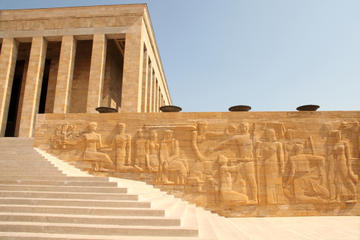
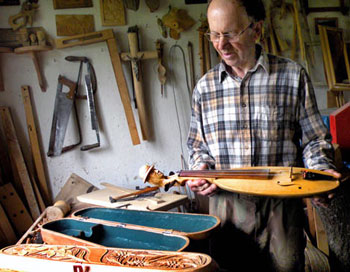
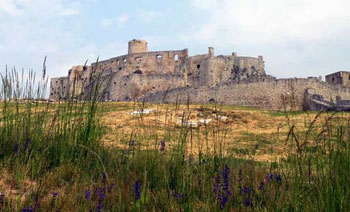 Our hosts, the Filip family, take us by car on day-long outings to towns and sites of particular historic and personal interest. In the foothills, the lush green rolling countryside is planted in canola, maize and barley. Narrow country roads are lined with evenly spaced apple trees. And to the Northwest, the serrated peaks of the High Tatras are always in view.
Our hosts, the Filip family, take us by car on day-long outings to towns and sites of particular historic and personal interest. In the foothills, the lush green rolling countryside is planted in canola, maize and barley. Narrow country roads are lined with evenly spaced apple trees. And to the Northwest, the serrated peaks of the High Tatras are always in view.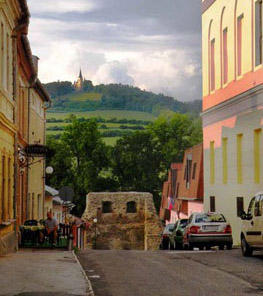 A wonderful surprise is the lovely walled town of Levoca, a former royal city and cultural centre of the Slovak national Enlightenment in the late 18th century. There are arched gateways and streets lined with medieval buildings in pastel colours. Among its landmarks are the 14th century St. James church, with the highest wooden altar in Europe, the 18th century theatre, the multi-columned 19th century town hall, and the open-air “shaming cage,” where transgressors were publicly punished. A basilica and field on a nearby hill is a traditional pilgrimage site, where Pope John Paul II once celebrated mass for over 600,000.
A wonderful surprise is the lovely walled town of Levoca, a former royal city and cultural centre of the Slovak national Enlightenment in the late 18th century. There are arched gateways and streets lined with medieval buildings in pastel colours. Among its landmarks are the 14th century St. James church, with the highest wooden altar in Europe, the 18th century theatre, the multi-columned 19th century town hall, and the open-air “shaming cage,” where transgressors were publicly punished. A basilica and field on a nearby hill is a traditional pilgrimage site, where Pope John Paul II once celebrated mass for over 600,000. Robert himself felt the oppression as a bright high school student near the end of the Communist period, when church attendance was still discouraged and he was warned that openly practising his faith could hurt his chances of going to university and having a successful career. But then came the Velvet Revolution and the independence of predominantly Catholic Slovakia. One Sunday morning we watch as a stream of proud parents, decked out in their finery, lead their children to the local church in elegant white robes and muster them for a procession and their first communion.
Robert himself felt the oppression as a bright high school student near the end of the Communist period, when church attendance was still discouraged and he was warned that openly practising his faith could hurt his chances of going to university and having a successful career. But then came the Velvet Revolution and the independence of predominantly Catholic Slovakia. One Sunday morning we watch as a stream of proud parents, decked out in their finery, lead their children to the local church in elegant white robes and muster them for a procession and their first communion.
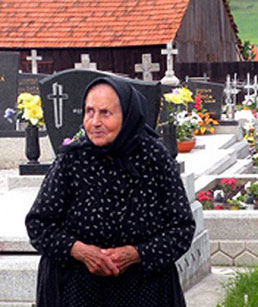 Then we visit an elderly relative who lives in a tiny village and wears the black shawl and somber dress of mourning. A closer look reveals that, although dark, the fabrics and stitching are incredibly ornate and detailed. Opening her closet, she displays her extensive wardrobe and admits a bit sheepishly that women like to appear in church in the finest and most elegant clothes. And she has sewn everything herself, all her life. She takes us to the cemetery and shows us the grave of Annie’s great-grandmother, which she regularly tends with flowers and devotion.
Then we visit an elderly relative who lives in a tiny village and wears the black shawl and somber dress of mourning. A closer look reveals that, although dark, the fabrics and stitching are incredibly ornate and detailed. Opening her closet, she displays her extensive wardrobe and admits a bit sheepishly that women like to appear in church in the finest and most elegant clothes. And she has sewn everything herself, all her life. She takes us to the cemetery and shows us the grave of Annie’s great-grandmother, which she regularly tends with flowers and devotion.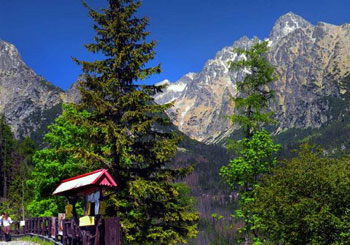 We also spend glorious days in the High Tatra mountains. We ride a funicular railway up into Tatra National Park and hike through the forest of red spruce to a remote waterfall on a major stream. Thunderous water spirals into deep gurgling holes as we sit on a gigantic weathered boulder and enjoy a picnic. There are no mosquitoes to spoil things, even in early June.
We also spend glorious days in the High Tatra mountains. We ride a funicular railway up into Tatra National Park and hike through the forest of red spruce to a remote waterfall on a major stream. Thunderous water spirals into deep gurgling holes as we sit on a gigantic weathered boulder and enjoy a picnic. There are no mosquitoes to spoil things, even in early June.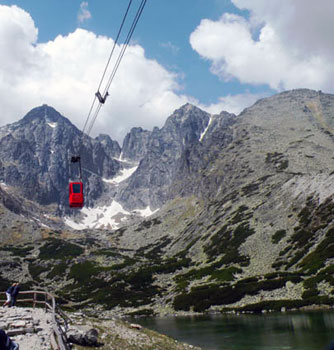 The Tatra region is known for its enchanting alpine villages. Log-built and chalet-style houses feature large balconies, colourful window shutters and other fanciful and ornate woodwork. There are centuries-old wooden churches and attractive, affordable boutique hotels that are popular in summer with hikers, campers and lovers of wildlife. In winter, they host skiers from all over Europe. We spend a night in one of them, in a romantic top floor room with dormers, and eat in a restaurant that serves local wild game and freshly caught fish from the lakes and streams. But most evenings, Terezia pampers us with her Slovak home cooking, a rich cuisine that starts with tasty soups and moves on to pork or chicken main dishes, plus potatoes from their large garden, or pirogies, or dumplings with butter or gravy. And then comes dessert. They say that if you don’t gain weight while visiting Slovakia, you have not been treated to true Slovak hospitality. And so we do.
The Tatra region is known for its enchanting alpine villages. Log-built and chalet-style houses feature large balconies, colourful window shutters and other fanciful and ornate woodwork. There are centuries-old wooden churches and attractive, affordable boutique hotels that are popular in summer with hikers, campers and lovers of wildlife. In winter, they host skiers from all over Europe. We spend a night in one of them, in a romantic top floor room with dormers, and eat in a restaurant that serves local wild game and freshly caught fish from the lakes and streams. But most evenings, Terezia pampers us with her Slovak home cooking, a rich cuisine that starts with tasty soups and moves on to pork or chicken main dishes, plus potatoes from their large garden, or pirogies, or dumplings with butter or gravy. And then comes dessert. They say that if you don’t gain weight while visiting Slovakia, you have not been treated to true Slovak hospitality. And so we do. Our final day, we visit Michlik, the carver and instrument maker, a long-time friend of the Filips, who has been featured in documentaries on Slovak national television and played his stringed instruments in a local folk music group. In his village, Zdiar, people speak a dialect, Goral, that is closer to Polish than to Slovak, a vestige of centuries of Polish rule over the region. He regales us with stories about his life. For many years, he was part of a hunting club with access to some of Europe’s most pristine alpine wilderness, where boar, lynx and mountain goat still run free. During the Communist period, he supplemented his carving income by keeping sheep and renting out rooms, mainly to tourists from East Germany. He takes us through his workshop, where antique hand tools coexist with a modern lathe and band saw. His latest violin, and its ornately carved wooden case, will be an 18th birthday present for his grand-daughter. We see racks of carefully stacked wood that has to air dry for three to five years. Most of it is now earmarked for his grandson, Marek, who apprenticed under him and is carrying on the proud tradition.
Our final day, we visit Michlik, the carver and instrument maker, a long-time friend of the Filips, who has been featured in documentaries on Slovak national television and played his stringed instruments in a local folk music group. In his village, Zdiar, people speak a dialect, Goral, that is closer to Polish than to Slovak, a vestige of centuries of Polish rule over the region. He regales us with stories about his life. For many years, he was part of a hunting club with access to some of Europe’s most pristine alpine wilderness, where boar, lynx and mountain goat still run free. During the Communist period, he supplemented his carving income by keeping sheep and renting out rooms, mainly to tourists from East Germany. He takes us through his workshop, where antique hand tools coexist with a modern lathe and band saw. His latest violin, and its ornately carved wooden case, will be an 18th birthday present for his grand-daughter. We see racks of carefully stacked wood that has to air dry for three to five years. Most of it is now earmarked for his grandson, Marek, who apprenticed under him and is carrying on the proud tradition.
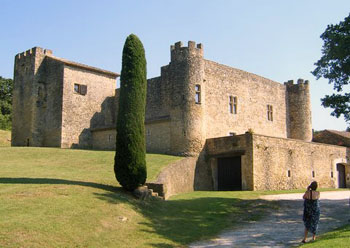
 Medieval Fontaine-de-Vaucluse nestles among chalky cliffs to the east. After strolling to its renowned spring, the largest in France, we savor luscious crepes at an open-air bistro overlooking its emerald stream. From picture-perfect Gordes, a white stone village clustered atop a hilltop, we hike the rugged trail to enchanting Abbey of Sénanque, set among perfumed lavender fields and golden wheat that undulate in warm breezes. And inside walled Pernes-les-Fontaines, a self-guided walking map guides us to many of its forty treasured fountains.
Medieval Fontaine-de-Vaucluse nestles among chalky cliffs to the east. After strolling to its renowned spring, the largest in France, we savor luscious crepes at an open-air bistro overlooking its emerald stream. From picture-perfect Gordes, a white stone village clustered atop a hilltop, we hike the rugged trail to enchanting Abbey of Sénanque, set among perfumed lavender fields and golden wheat that undulate in warm breezes. And inside walled Pernes-les-Fontaines, a self-guided walking map guides us to many of its forty treasured fountains. Entering the Palais des Papes through enormous portals, we meander through its arched courtyards and into halls with vaulted ceilings, huge treasury rooms and even the colossal kitchen tower. Exhibits and illustrated storyboards explain how in 1309, Pope Clement V escaped the turbulence of Rome to reside in Avignon. A subsequent pope bought Avignon from Queen Joanna I of Sicily for 80,000 gold gulden. And over a span of 68 years, this vast fortified religious fortress protected and pampered seven consecutive popes until the papacy officially returned to Rome.
Entering the Palais des Papes through enormous portals, we meander through its arched courtyards and into halls with vaulted ceilings, huge treasury rooms and even the colossal kitchen tower. Exhibits and illustrated storyboards explain how in 1309, Pope Clement V escaped the turbulence of Rome to reside in Avignon. A subsequent pope bought Avignon from Queen Joanna I of Sicily for 80,000 gold gulden. And over a span of 68 years, this vast fortified religious fortress protected and pampered seven consecutive popes until the papacy officially returned to Rome. Delighting in cool breezes off the Rhone, we later approach this bridge. Humming the catchy children’s song immortalizing St. Benezet’s bridge, we zanily sing, “Sur le pont d’Avignon, l’on y danse, l’on y danse,” over and over. Circling round and round, we dance our way across the remains of this fabled structure…to the amusement of others strolling there.
Delighting in cool breezes off the Rhone, we later approach this bridge. Humming the catchy children’s song immortalizing St. Benezet’s bridge, we zanily sing, “Sur le pont d’Avignon, l’on y danse, l’on y danse,” over and over. Circling round and round, we dance our way across the remains of this fabled structure…to the amusement of others strolling there. Along many others, we stream back along this angel-inspired bridge and imagine those alluring bygone days. We then thread our way down cobbled streets to other shaded plazas and discover venerable cathedrals displaying resplendent artistry including refurbished mansions serving as fine art museums. Lingering in open-air bistros over buttery croissants thick with local cheeses and pungent lattes, we contemplate the extravagances of Avignon’s past glory days.
Along many others, we stream back along this angel-inspired bridge and imagine those alluring bygone days. We then thread our way down cobbled streets to other shaded plazas and discover venerable cathedrals displaying resplendent artistry including refurbished mansions serving as fine art museums. Lingering in open-air bistros over buttery croissants thick with local cheeses and pungent lattes, we contemplate the extravagances of Avignon’s past glory days.
 Mature plane trees shade the ancient forum, today bustling with shops, hotels and bistros, including Le Cafe la Nuit depicted by Van Gogh in Cafe Terrace at Night. The brilliant yellow walls, awnings and tablecloths recreate this acclaimed impressionist’s luminous effect of shimmering evening lights. Sipping café-au-lait and munching flaky-fresh croissants there, we notice a chunk of the original Roman Forum in the façade of Nord-Pinus Hotel across the way. And just off the square, Hotel d’Arlatan incorporates thick walls from Emperor Constantine’s extravagant royal residence.
Mature plane trees shade the ancient forum, today bustling with shops, hotels and bistros, including Le Cafe la Nuit depicted by Van Gogh in Cafe Terrace at Night. The brilliant yellow walls, awnings and tablecloths recreate this acclaimed impressionist’s luminous effect of shimmering evening lights. Sipping café-au-lait and munching flaky-fresh croissants there, we notice a chunk of the original Roman Forum in the façade of Nord-Pinus Hotel across the way. And just off the square, Hotel d’Arlatan incorporates thick walls from Emperor Constantine’s extravagant royal residence.